
It is essential to eat a healthy diet in order to maintain optimal nutrition. This will help you avoid many illnesses including cancer and noncommunicable disorders (NCDs). A wide range of nutritious foods is essential to ensure your body has enough nutrients.
Vegetables, fruits, whole grains, and legumes are all healthy foods. Vegetables offer a rich source of vitamins minerals and fiber. As an example, spinach is rich in at least 12 flavonoids. It also contains a lot of iron and vitamin C. Bell peppers are rich in antioxidants and taste great raw. Winter squash is another good source of antioxidants. Bananas contain a lot of fiber and have low calories.
Each day you should have at least three meals, along with a snack, and plenty of water. There are many foods you can choose from. It's important that you know the exact amount of added sugar and saturated fat that you are eating. Saturated oils are found in animal products like butter, bacon, ice cream, and other dairy products. Instead, choose vegetable oils and nut oils.

Fruits are a great way to keep your blood sugar steady, and are an excellent source of vitamins and antioxidants. Apples, bananas, strawberries and oranges are some of the most common fruit choices. Make sure you read all labels on fruit juices and packaged fruits to avoid any added sugar.
Dairy products are a good source of calcium as well as protein. Low-fat, unsweetened milk can be a great way to meet your daily nutritional requirements. Low-fat yogurt, cheese and other options are available. Whole milk can also be a source of high quality animal protein.
Protein-rich foods include seafood, poultry, eggs, and meat. Tuna, salmon and other fish are excellent sources of omega-3 Fatty Acids. Seafood is also an excellent source of iodine.
You should eat a wide range of fruits and vegetables as part of a healthy diet. They are among the most nutritionally dense foods on earth. Because they contain all of your body's essential minerals, protein, and vitamins

If you're on a diet, prepare your meals in advance. It's a good idea to have a variety of food and, if possible cook in bulk. It is also a smart idea to carry easy-to eat snacks with you. You will be able to reach your nutrient needs by keeping a bowl full of fresh fruits at the house.
Whole grain flours can be added to your meals for extra nutrition. Brown rice, whole grain bread and oatmeal are all good options. Be sure to buy low-mercury varieties, which are less likely to cause harmful levels of mercury in your system.
Whole grain foods will help you feel fuller for longer. Many of these foods contain high levels of fiber, which is crucial in reducing your chance of developing heart disease. You can get a lot of protein from adding nuts, seeds, soy products, and other nutrients to your diet.
FAQ
What is the most effective strategy to maintain or lose weight?
While weight loss and weight maintenance strategies look very similar, there are still some differences.
Weight loss refers to losing weight more than it does about maintaining that weight.
The difference is that you want to lose weight while you're trying to lose pounds. While you want to maintain your weight, you have to do so in a different way.
Both require dedication and discipline. Weight loss requires more effort as you have to do something. Weight maintenance, however, is simpler. You need to remain disciplined.
Both must be healthy and you should exercise regularly.
To lose weight, you must change your eating habits. You also need to exercise regularly.
Weight maintenance can be easier if you are disciplined. You must eat healthy food and exercise regularly to maintain your weight.
So what should you choose? The best way to decide is by taking into account your current lifestyle.
Weight loss may be easier if you eat fast foods occasionally and exercise only occasionally.
However, maintaining your weight may be easier if you eat healthy food and exercise regularly.
Ultimately, it all comes down to personal preference.
It's important that you understand that losing weight doesn’t necessarily mean being thin.
You can feel happier and healthier by losing weight.
For weight loss, change your eating habits, and get regular exercise.
You'll see results faster than ever before.
What is the healthiest breakfast you can eat?
It can be difficult to get a healthy breakfast. Some foods are better than others. Let's take a look at them all and see which are the best.
The first step is to calculate your daily fat requirements. This means knowing your daily calorie needs. Then we'll look at the most important nutrients in food and determine which ones you should focus on.
Next, let's go over the recommended breakfasts. We'll then choose the healthier choices. We will also discuss the reasons these foods might be better than others.
Finally, we'll look at some of the worst choices for breakfast and explain why they aren't worth eating.
Let's ask the simple question: What is the most healthy breakfast?
There's no simple answer. It is dependent on many factors. Your personality, your lifestyle, whereabouts, children and other factors will all play a part in how you feel.
These are our top three picks, after considering all of these things.
-
Eggs are one of the few whole foods that can help you lose weight. They're high in protein, which helps to build muscle and keep your stomach full. Research has shown that people who eat eggs tend not to gain weight. You also want to choose organic eggs because they're free of pesticides and antibiotics.
-
Greek Yogurt contains about five times the protein as regular yogurt. This makes Greek yogurt a great way to increase your intake of high quality protein. Controlling your hunger is important.
-
Oatmeal is filling and nutritious. It doesn't need to be prepared. Oatmeal has fiber, which slows down digestion. You feel fuller for longer. Oatmeal is rich in antioxidants but you probably won’t notice as you’ll likely be drinking coffee and tea alongside it. Both of those beverages contain loads of caffeine, which reduces the antioxidant benefits of oats.
Let's get on to the next question.
Here's the short answer: It depends.
A bagel from the grocery shop is a good option if you are looking for something quick. Bagels are low-calorie and high in carbs.
You don't even have to cook them, making them very convenient!
However, bagels are not good for you. Research has shown that bagels are a good choice for people who want to lose weight.
Even though bagels are now lower in sodium, they still contain lots of sugar.
You can also grab a muffin from the bakery section of your supermarket. These are typically baked with white flour and butter.
Muffins and scones can be filled with fruits, nuts, or other healthy ingredients. These muffins and scones could be better options than a simple bagel.
There is no bad breakfast choice. But you do want to ensure that whatever you eat will fill you up without making you too hungry later in the day.
What diet works best for losing weight?
Losing weight is possible by eating less calories than you consume each day. This means that you eat smaller portions throughout the day.
Reduce the intake of added sugars or fats to reduce calories. Eating healthy foods such as fruits, vegetables, lean meats, whole grains, low-fat dairy products, nuts, beans, seeds, and fish can help you achieve your goals.
A healthy diet can prevent cardiovascular disease, type 2 diabetes and osteoporosis.
To ensure you're getting enough nutrients, try adding supplements like vitamin D, calcium, magnesium, zinc, iron, omega-3 fatty acids, and probiotics.
Intermittent fasting is a great way to quickly lose weight. Intermittent fasting allows you to eat only during certain hours of the day.
This method allows you to eat five meals per day, and one meal each night. The remaining four meals are spread out over the day.
This technique makes it less likely that people will feel hungry as their bodies won't adjust to eating so much.
What are the five keys to a healthy diet and lifestyle?
You might have heard the phrase "You are what is in your stomach." A healthy diet consists of five elements.
These include eating plenty and vegetables, avoiding processed and refined foods, drinking lots and water, regular exercise, and limiting alcohol.
These three essential elements are vital for your overall health. The last two are crucial for weight control.
You can ensure that these nutrients are consumed by adding them to your daily meal.
You should eat a variety of fresh produce like fruits, leafy vegetables, and whole grain. These foods contain vitamins C, D, and E which protect against heart disease, cancer, and other diseases.
Avoid processed food, including those containing artificial ingredients and preservatives. This includes soft drinks, candy bars, cookies, and chips.
Eight glasses of water daily is a good way to keep your body hydrated. It prevents dehydration and keeps your metabolism in check.
An important part of a healthy lifestyle is exercise. If you aren't active, you run the risk for obesity-related conditions like diabetes, heart disease and stroke.
Limit your alcohol intake. Alcoholic beverages increase blood pressure, cause headaches and contribute to liver damage.
You will live a happier life if you follow these tips.
What is the best drink for health?
If we look for the most healthy drink in the world, we find out that there isn't any. Some drinks are better for you than water, but they're not the best.
This is because you choose the drink that you like. When we ask "What is the healthiest beverage?" we mean "which is my favorite drink."
This means that it is not surprising that there are many variations depending on where you live. Even within countries, the answer varies wildly.
Green tea is the preferred choice in Japan while coffee wins in New Zealand. In India milkshakes are very popular, but in Australia beer reigns supreme.
In the end, it doesn’t really matter what healthiest drink you choose because everyone has their/her own preference.
What is most important is the health of the drink. But again, the definition of healthy differs greatly from person to person.
A glass of wine may be unhealthy for someone, but it might be perfectly fine for another. One person may find a glass red wine mixed with a slice of cake unhealthy, while another person may find it healthy.
There is no universal standard for defining healthiness. Even more, there is not one universal way to measure healthiness.
So, it is not possible to say that one beverage is healthier than the next. This statement cannot be made without knowing how many alcoholic beverages are in each one.
Even if this was known, the amount of alcohol we consume will still pose a problem. A white wine is far less caloric than a red wine.
Although we can compare various beverages based upon their calorie content we cannot say that one beverage or another is healthier.
One way to determine the percentage of alcohol in each drink is to create a formula. But, it would only account for the alcohol amount and not its composition.
Even if it were possible to do so, it would still be necessary to know the exact formula of each beverage. This information cannot be accessed at all times.
Restaurants may not disclose the ingredients in their food. Some people don’t like it when others know what they eat.
However, we can't tell which drink tastes better.
What foods can clean your arteries?
Eat right to maintain your heart health. But what does that actually mean? There are many methods to accomplish this. One is to eat more fruits and veggies.
Vegetables and fruits are rich in antioxidants that help to prevent diseases and improve your overall health. Antioxidants fight inflammation and prevent clogged arteries.
But there are other ways to reduce the amount of cholesterol in your diet too. You can lower your chance of suffering from a heart attack by cutting down on saturated fats like butter and trans-fatty acid (found in fried foods).
You can increase fiber intake. This will keep your blood flowing freely throughout your body. LDL, the bad cholesterol that can increase your risk of cardiovascular disease, is reduced by fiber.
Beyond what you put in the mouth, there are other factors that can impact your heart health. Stress, smoking, obesity and alcohol consumption all play a part in your risk of developing heart disease.
Talk to your doctor if you are at high risk for developing heart disease. You may need to take medications or make lifestyle changes to stay healthier.
Statistics
- Overall (tie) Whole30 lacks scientific support and is severely restrictive, according to the experts. (health.usnews.com)
- Recommendation Saturated fat is less than 6% of total daily calories. (mayoclinic.org)
- For example, a review of 45 studies found that people who followed a WW diet lost 2.6% more weight than people who received standard counseling (26Trusted Source (healthline.com)
- Trim fat off meat or choose lean meats with less than 10% fat. (mayoclinic.org)
External Links
How To
Healthy Eating Guidelines For Kids
To be healthy, children need to eat a healthy diet. Children who eat well have a tendency to be healthier adults. Here are some guidelines that you should follow when feeding children.
-
Sugary drinks should be limited. Sugary beverages account for more sugar than half of the total sugar intake in children between 2 and 18 years old.
-
Limit juice. Juice is full of empty calories, and very little nutrition.
-
Avoid fried food. Fried foods are high in saturated fats and transfats which can increase blood cholesterol and raise heart disease risk.
-
Whole grains are best. Whole grains provide important nutrients such as dietary fiber, B vitamins, magnesium, phosphorus, protein, and zinc.
-
Fresh produce is a good choice. Fresh fruits, vegetables, and legumes are high in vitamins, minerals, as well as fiber. They also contain less sodium that processed or packaged foods.
-
Choose lean meats. Lean meats offer high-quality protein with fewer calories and fat than fatty cuts.
-
Be careful with snacks. Snacks can add calories and other unhealthy ingredients to your meals. Many snack products are made from refined flour and hydrogenated oils.
-
Breakfast is a must for every child. Breakfast boosts metabolism and provides energy for daily activity.
-
Try out new recipes. Explore new recipes and see what you like. Try adding spices and herbs to dishes to change the flavor profile.
-
Get active. Physical activity is an important part of childhood. It helps improve concentration, memory, mood, and overall well-being. Exercise helps you lose weight.
-
Get outside. Enjoy the natural beauty of nature. Enjoy the outdoors by hiking, biking, swimming or simply enjoying the great outdoors.